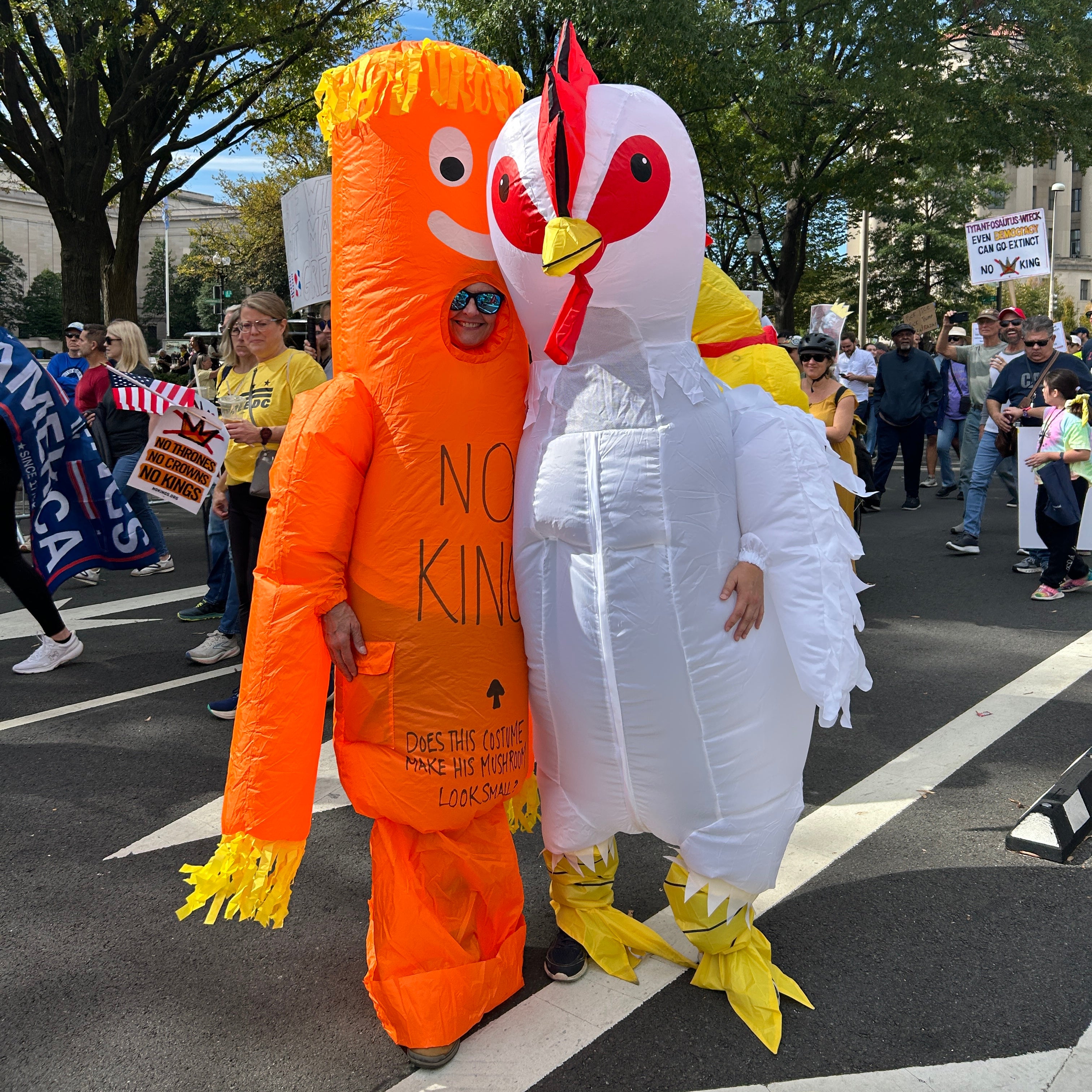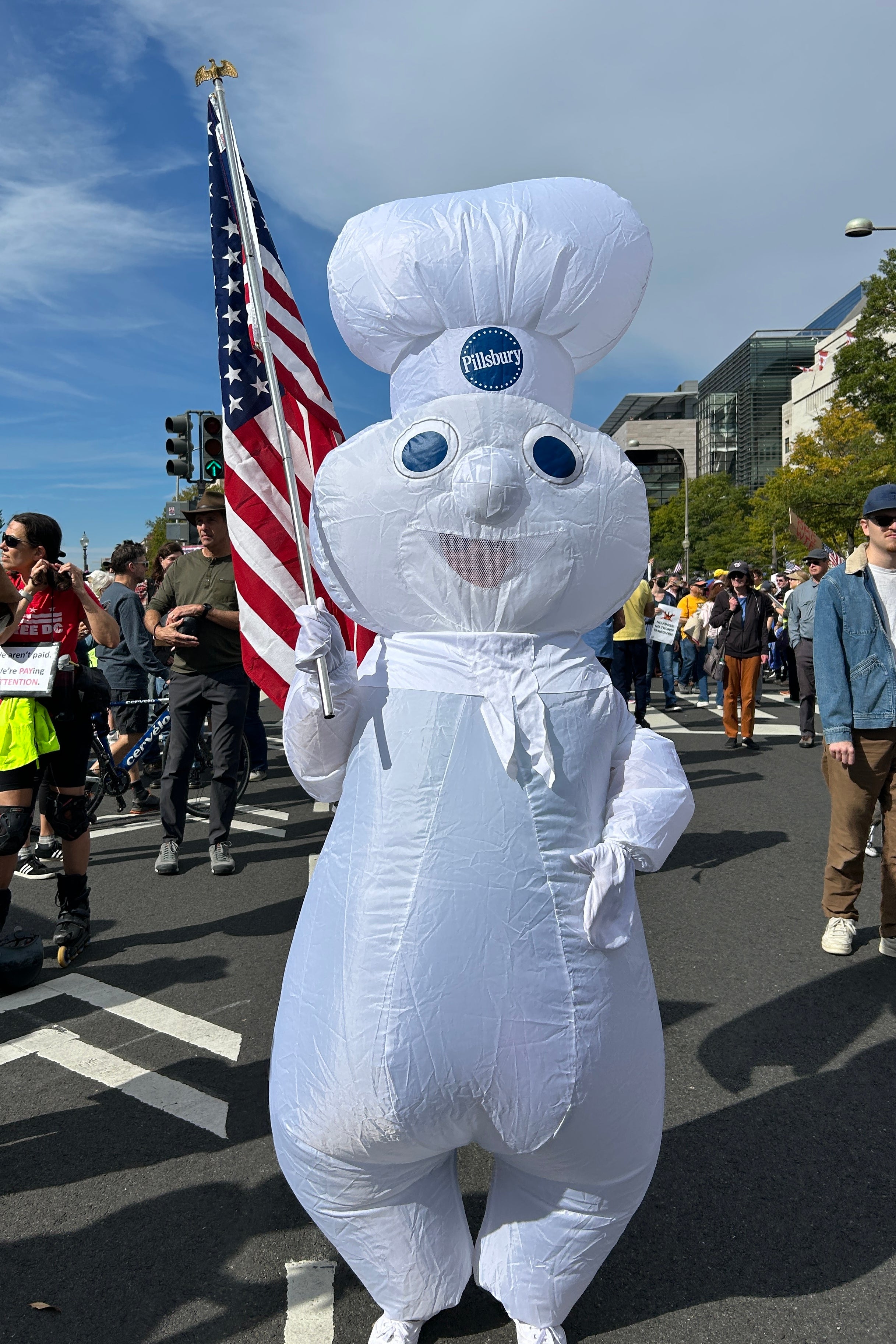Sign up for the Slatest[1] to get the most insightful analysis, criticism, and advice out there, delivered to your inbox daily.
Over the past decade, Donald Trump’s opponents have struggled to find an effective answer to the rise of right-wing authoritarianism. There have been deeply earnest, sign-carrying boomers. There have been Antifa-inflected, black-clad protestors ready to spar with militarized Immigration and Customs Enforcement agents.
What there had not been, however, were inflatable frogs.
That is until Donald Trump sent troops to Portland, where ICE agents ran headlong into a 24-year-old in a blow-up frog suit named Seth Todd. Todd met a line of grim ICE agents by dancing and thrusting his hips. An agent sprayed pepper spray directly into his air vent, but he wasn’t defeated. Instead, more inflatable frogs joined him in the days that followed, dancing in the streets.
Fast-forward to Saturday’s “No Kings” protests, a coordinated series of protests in cities and towns nationwide. Here in Washington, D.C., it became clear that inflatable frog absurdity has become the resistance’s weapon of choice.
At a mass protest on downtown’s Pennsylvania Avenue, the joking signs outnumbered the serious. There were people in colonial America costumes and in clown costumes; some signs mentioned “6-7[2].” One protester held a sign calling for Tom Cruise to save them; another accused Trump of loving Nickelback. One group carried a Flying Spaghetti Monster[3] banner. There were some old hits—the Handmaid’s Tale costumes from the Women’s March days, for example, and tiny hands. But there were more references to antifa: some women dressed as “Aunt Tifa” with reading glasses and curlers in their hair, a reference to Republican efforts to portray anti-fascist protesters as extremists.
Advertisement
Advertisement
Advertisement
Advertisement
“I Stand with Frog Dude,” one banner read. Another: “No Kings, Only Frogs.”
It’s a joke, but it’s not only a joke. At a time when the administration is seeking to portray its political opponents as seditious enemies—ones worthy of violence and prosecution—the injection of levity is a matter of strategy: In some No Kings protests, organizers encouraged participants to show up in Halloween costumes. These organizers aimed to deny the administration what it had been desperately seeking: an enemy serious enough to justify an emergency declaration.
“What they want is their Reichstag Fire,” said Sedef Buyukatiman, a protester wearing an inflatable unicorn costume. “They want something to go wrong. They desperately are looking for a way to bring about martial law so they can abolish what’s left of our Constitution, and I just don’t want to give them that opportunity.”
At the No Kings March in Washington, D.C., there was no greater rejection of the Trump administration’s desired boogeyman than the presence of inflatable costumes—unwieldy walking cushions, literally incapable of fighting or posing any kind of threat to anyone.
Advertisement
There was, among the rotund tottering creatures, a giraffe, an “Among Us” alien, a left shark[4], a bald eagle, an alligator, a Pillsbury Doughboy, a raccoon, a chicken, a rubber chicken, a waving tube man, an axolotl, a Patrick from Spongebob Squarepants, and many unicorns. And there were, of course, frogs. Some were repurposed Halloween costumes; most had been purchased in the last week from the internet or Spirit Halloween, having been inspired by the Portland frog.
Advertisement
Asked why they were wearing inflatables, most said they wanted to force the Trump administration to face the absurdity of their narratives. One person, who was dressed as a raccoon put it: “They’re trying to say that these people here are terrorists. Well, clearly the unicorn is not a terrorist.”
Advertisement
These bubbly creatures seemed to float by on the positive energy of the crowd, sometimes blithely bopping along, sometimes stopping to take photos with enthusiastic fellow inflatable-wearers. Behind this goofiness was, to the wearers, a real political goal.
Advertisement
The inflatable wearers also mused about deeper philosophical questions about the nature of protest. It remains a matter of debate, after all, whether the Black Lives Matter protests were a success. The movement certainly shook up the culture at the time, but we are now experiencing a profound backlash. The very concept of standing up for civil rights has become taboo in much of public life. It’s possible that the anger and seriousness of that movement ultimately led to its own undoing. Could silliness be the safeguard against such a backlash? Can revolution succeed by being fun?
One of the frogs, a man who declined to give his name for fear of repercussions at his workplace, said he sees value in the silliness. He said he normally does not participate in protests; instead, he said, he tends to put more energy in his behind-the-scenes work in politics, which he considers serious. But he bought his frog costume last week with the idea of embracing “fun and whimsy” in political opposition to authoritarianism.
Advertisement
Advertisement
Advertisement
“We also need to bring the whimsy so that we can bring people into the movement; Not everyone’s gonna be attracted by just seriousness,” he said. “We’re all too damn sad. We’re depressed, and we’ve got to be, like, happy warriors… If we are just angry and sad, no one’s going to join us.”

Advertisement
Advertisement
A mother-daughter unicorn duo expressed the same feeling. The two, who were from Frederick, Maryland, said they attend protests two to three times a week. The daughter, a 21-year-old named Ramsey, had discovered the Portland frog on TikTok and been charmed. “Fun and lightness,” the two argued, made protests available for all ages and helped protesters feel like they’re part of a community.
Advertisement
That particular kind of solidarity became visible moments later as the unicorns explained that they had, at various times, leaned on the bonds they formed with other protesters for emotional support.
“We’ve gotten scared, and we feel a little intimidated sometimes,” the elder unicorn said. “But we have a strong community—”
She was cut off when a giant inflatable baby barreled into them.
“Fat people solidarity,” the baby yelled in a Trump voice. The baby’s face, belonging to an adult man, was painted orange. Both unicorns yelled with delight.
“Inflatable nation!” the younger unicorn said.
“It’s my first time in one of these,” the baby said. “It’s hot in these bitches!”
Advertisement
That sense of inflatable kinship carried through these interactions, with occasional awkward attempts at high-fives and hugs between strangers. (The inflatables cut off peripheral vision.) A meeting of different chickens led to a particularly strong eruption of glee. But it seemed that some of these inflatable wearers were donning their costumes as much for themselves as they were for the onlookers.
“I’ve been scared for the first time in my life to come out to protest,” Buyukatiman, the unicorn, said. “And when I saw what was going on in Portland—the right framing for these people is to laugh at them, make fun of them, and show up in peaceful protests. So that’s why I’m here. I said, ‘I’m tired of being afraid, and I’m going out in my unicorn outfit.’”
Advertisement
Advertisement
Advertisement
“Almost everyone that I know tells me that I’m too serious,” said yet another unicorn, a woman named Devidyal. “I take everything really, really seriously. I’m a world history teacher, and I am terrified of what I see. And I just decided: they don’t take us seriously when we’re serious. So why not be silly?”
Advertisement
The unicorn’s husband, Brandon Givens, a raccoon and a candidate for 11th District House of Delegates in Virginia, said he and his wife had witnessed authoritarianism in Kazakhstan as teachers there. “We thought, hey, you know, one of the best ways to fight fascism and authoritarianism is to mock it,” he said. “Because they’re trying to say that these people here are terrorists. Well, clearly the unicorn is not a terrorist.”

Advertisement
Advertisement
Back in the first Trump administration, some of the anti-Trump protests were criticized for being too unspecific[5] and shallow. They were, critics said, full of smiling people who looked like they were out for a stroll with friends, rather than fighting for their rights. They were too polite, some argued, and too palatable to white moderates[6]; the pink pussy hats were eventually seen as embarrassing.
Advertisement
But the protesters argued that anyone who questioned their seriousness missed the point: they were laughing at fascism, they said, to show they were stronger, as a public. And the inflatables weren’t just there having a good time. Mike, one of the frogs, pointed out that the suits took commitment.
“I mean, if anything—this suit’s kind of hot and uncomfortable, and I’m taking the effort to actually do it,” he said.
Indeed, all of the inflatable users appeared to be overheating; it was in the mid and upper 60s, but the sun was direct, and several people spoke through fogged-up plastic panels with visibly sweat-slicked hair.
Advertisement
Mike the frog walked along the route as sounds clashed around him: chants of “this is what democracy looks like”; tubas booming out marching band numbers; an a capella rendering of the National Anthem; what appeared to be an original rap composition about Trump from a nearby loudspeaker; and 18th Century fife music coming from some invisible source. There was chaos to it all, and very few dour faces.
Advertisement
Advertisement
The DC inflatables were not powerful as symbols the way the Portland frog is; their absurdity did not clash so dramatically against their fellow goofy marchers. But they served to testify to the Portland Frog’s strategic success. Maybe this protest will prove ineffective in creating any kind of greater change. But for now, they’ve exposed the absurdity behind the right-wing narratives—and that might be enough to remind some Americans that, despite what Fox News has said, there isn’t an emergency in these streets. There are just inflatable figures dancing.
“It’s so silly,” said Mike the frog. “There’s nothing more innocuous and harmless in a frog, right?”
References
- ^ Sign up for the Slatest (slate.com)
- ^ 6-7 (slate.com)
- ^ Flying Spaghetti Monster (www.nytimes.com)
- ^ left shark (www.npr.org)
- ^ unspecific (www.nature.com)
- ^ palatable to white moderates (www.aljazeera.com)
- ^ Brett Kavanaugh Is Carving Out Quite a Little Legacy for Himself (slate.com)
- ^ This Content is Available for Slate Plus members only Trump Is Exploiting the Shutdown to Set Up Something Truly Terrifying (slate.com)
- ^ Here’s What It Looks Like When Vladimir Putin Takes Over Your Child’s Classroom (slate.com)
- ^ This Content is Available for Slate Plus members only The One Possible Bright Spot in the Supreme Court’s Massive Voting Rights Act Case (slate.com)
